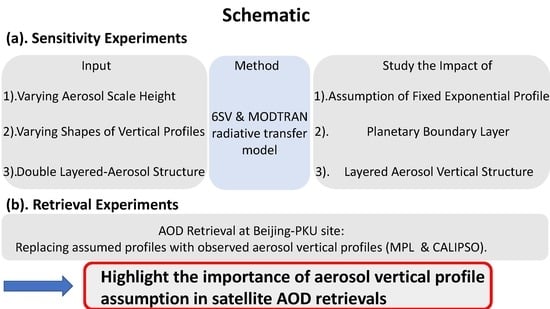Impact of Aerosol Vertical Distribution on Aerosol Optical Depth Retrieval from Passive Satellite Sensors
Abstract
1. Introduction
2. Description of Radiative Transfer Models
2.1. 6SV Radiative Transfer Model
2.2. MODTRAN Radiative Transfer Model
3. Datasets Used for the Retrieval Experiment Using Observed Profiles
3.1. VIIRS Level 1B Data
3.2. Micro-Pulse Lidar Aerosol Extinction Profiles
3.3. CALIPSO Data
3.4. AERONET Data
4. Experiments and Results
4.1. Impact of Aerosol Scale Height Assuming Exponential Profile
4.2. Impact of the Planetary Boundary Layer
4.3. Impact of Layered Aerosol Vertical Structure
4.4. AOD Retrieval Using Observed Aerosol Vertical Profiles
5. Discussion
6. Conclusions
- The retrieved AOD is the most sensitive to aerosol vertical distribution for fine absorbing aerosols. The relative errors can exceed 30% for a −1-km scale height uncertainty when AOD = 0.2.
- The surface albedo has a large impact on the ΔAOD–Δscale height relationship. At a lower surface albedo, the AOD error varies positively with scale height error, but it shifts to negative relationships when surface albedo increases to 0.1. The AOD error becomes less sensitive to scale height error when surface albedo further increases.
- Neglecting the boundary layer will lead to an AOD error up to ~10% for absorbing aerosols at AOD = 0.2.
- For layered aerosol structure, failing to consider different aerosol types at different altitudes will lead to considerably large AOD errors. At 0.5 AOD, sulfate (scattering) lying below soot (absorbing) can produce positive errors as large as 28%, and the reverse case produces negative errors of ~18%.
- Replacing the exponential profile with the MPL derived aerosol extinction profiles can largely improve the accuracy of satellite retrieved AOD, especially during the winter season when aerosol absorption is strong. The overall bias can be reduced from 0.15 to 0.03 and the correlation is increased from 0.63 to 0.83. Replacing with spatial-average CALIPSO profiles also improves the AOD retrievals significantly in the winter season.
- Based on the distribution of aerosol optical properties, satellite AOD retrieval accuracy is more prone to errors in aerosol vertical assumption for Asia in winter, and South Africa and South America in the fall.
Author Contributions
Funding
Acknowledgments
Conflicts of Interest
References
- Geogdzhayev, I.V.; Mishchenko, M.I.; Rossow, W.B.; Cairns, B.; Lacis, A.A. Global two-channel AVHRR retrievals of aerosol properties over the ocean for the period of NOAA-9 observations and preliminary retrievals using NOAA-7 and NOAA-11 data. J. Atmos. Sci. 2002, 59, 262–278. [Google Scholar] [CrossRef]
- Levy, R.C.; Remer, L.A.; Dubovik, O. Global aerosol optical properties and application to Moderate Resolution Imaging Spectroradiometer aerosol retrieval over land. J. Geophys. Res. Atmos. 2007, 112. [Google Scholar] [CrossRef]
- Levy, R.C.; Mattoo, S.; Munchak, L.A.; Remer, L.A.; Sayer, A.M.; Patadia, F.; Hsu, N.C. The Collection 6 MODIS aerosol products over land and ocean. Atmos. Meas. Tech. 2013, 6, 2989–3034. [Google Scholar] [CrossRef]
- Jackson, J.M.; Liu, H.; Laszlo, I.; Kondragunta, S.; Remer, L.A.; Huang, J.; Huang, H.C. Suomi-NPP VIIRS aerosol algorithms and data products. J. Geophys. Res. Atmos. 2013, 118, 12673–12689. [Google Scholar] [CrossRef]
- Li, C.; Li, J.; Xu, H.; Li, Z.; Xia, X.; Che, H. Evaluating VIIRS EPS Aerosol Optical Depth in China: An intercomparison against ground-based measurements and MODIS. J. Quant. Spectrosc. Radiat. Transf. 2019, 224, 368–377. [Google Scholar] [CrossRef]
- Bilal, M.; Nazeer, M.; Qiu, Z.; Ding, X.; Wei, J. Global validation of MODIS C6 and C6.1 merged aerosol products over diverse vegetated surfaces. Remote Sens. 2018, 10, 475. [Google Scholar] [CrossRef]
- Mielonen, T.; Levy, R.C.; Aaltonen, V.; Komppula, M.; De Leeuw, G.; Huttunen, J.; Lihavainen, H.; Kolmonen, P.; Lehtinen, K.E.J.; Arola, A. Evaluating the assumptions of surface reflectance and aerosol type selection within the MODIS aerosol retrieval over land: The problem of dust type selection. Atmos. Meas. Tech. 2011, 4, 201–214. [Google Scholar] [CrossRef]
- Tirelli, C.; Curci, G.; Manzo, C.; Tuccella, P.; Bassani, C. Effect of the aerosol model assumption on the atmospheric correction over land: Case studies with CHRIS/PROBA hyperspectral images over Benelux. Remote Sens. 2015, 7, 8391–8415. [Google Scholar] [CrossRef]
- Wang, W.; Pan, Z.; Mao, F.; Gong, W.; Shen, L. Evaluation of VIIRS land aerosol model selection with AERONET measurements. Int. J. Environ. Res. Public Health. 2017, 14, 1016. [Google Scholar] [CrossRef]
- Wu, Y.; de Graaf, M.; Menenti, M. The sensitivity of AOD retrieval to aerosol type and vertical distribution over land with MODIS data. Remote Sens. 2016, 8, 765. [Google Scholar] [CrossRef]
- Wu, Y.; de Graaf, M.; Menenti, M. The impact of aerosol vertical distribution on aerosol optical depth retrieval using CALIPSO and MODIS data: Case study over dust and smoke regions. J. Geophys. Res. Atmos. 2017, 122, 8801–8815. [Google Scholar] [CrossRef]
- Kahn, R.A.; Gaitley, B.J. Atmospheres An analysis of global aerosol type as retrieved by MISR. J. Geophys. Res. Atmos. 2015, 12, 4248–4281. [Google Scholar] [CrossRef]
- Laszlo, I.; Liu, H.Q. EPS Aerosol Optical Depth (AOD) Algorithm Theoretical Basis Document; NOAA NESDIS Center for Satellite Application and Research: College Park, MD, USA, 2016.
- Levy, R.C.; Remer, L.A.; Mattoo, S.; Vermote, E.F.; Kaufman, Y.J. Second-generation operational algorithm: Retrieval of aerosol properties over land from inversion of Moderate Resolution Imaging Spectroradiometer spectral reflectance. J. Geophys. Res. Atmos. 2007, 112, 1–21. [Google Scholar] [CrossRef]
- Dubovik, O.; Herman, M.; Holdak, A.; Lapyonok, T.; Tanré, D.; Deuzé, J.L.; Ducos, F.; Sinyuk, A.; Lopatin, A. Statistically optimized inversion algorithm for enhanced retrieval of aerosol properties from spectral multi-angle polarimetric satellite observations. Atmos. Meas. Tech. 2011, 4, 975–1018. [Google Scholar] [CrossRef]
- Hsu, N.C.; Tsay, S.; King, M.D.; Member, S.; Herman, J.R. Aerosol Properties over Bright-Reflecting Source Regions. IEEE Trans. Geosci. Remote Sens. 2004, 42, 557–569. [Google Scholar] [CrossRef]
- Tao, M.; Wang, Z.; Tao, J.; Chen, L.; Wang, J.; Hou, C.; Wang, L.; Xu, X.; Zhu, H. How Do Aerosol Properties Affect the Temporal Variation of MODIS AOD Bias in Eastern China? Remote Sens. 2017, 9, 800. [Google Scholar] [CrossRef]
- Wang, W.; Mao, F.; Pan, Z.; Du, L.; Gong, W. Validation of VIIRS AOD through a Comparison with a Sun Photometer and MODIS AODs over Wuhan. Remote Sens. 2017, 9, 403. [Google Scholar] [CrossRef]
- Vermote, E.; Tanré, D.; Deuzé, J.L.; Herman, M.; Morcrette, J.J.; Kotchenova, S.Y. Second simulation of a satellite signal in the solar spectrum-vector (6SV). 6S User Guide Version 2006, 3, 1–55. [Google Scholar]
- Kotchenova, S.Y.; Vermote, E.F.; Levy, R.; Lyapustin, A. Radiative transfer codes for atmospheric correction and aerosol retrieval: Intercomparison study. Appl. Opt. 2008, 47, 2215–2226. [Google Scholar] [CrossRef]
- Anderson, G.P.; Berk, A.; Acharya, P.K.; Matthew, M.W.; Bernstein, L.S.; Chetwynd, J.H.J.; Dothe, H.; Adler-Golden, S.M.; Ratkowski, A.J.; Felde, G.W.; et al. MODTRAN4: Radiative transfer modeling for remote sensing. Proc. SPIE 2000, 4049, 176–183. [Google Scholar]
- Berk, A.; Anderson, G.P.; Acharya, P.K.; Bernstein, L.S.; Muratov, L.; Lee, J.; Fox, M.; Adler-Golden, S.M.; Chetwynd, J.H.; Hoke, M.L.; et al. MODTRAN 5: A reformulated atmospheric band model with auxiliary species and practical multiple scattering options: Update. Algorithms Technol. Multispectr. Hyperspectr. Ultraspectr. Imag. XI 2005, 5806, 662. [Google Scholar]
- Cao, C.; Xiong, J.; Blonski, S.; Liu, Q.; Uprety, S.; Shao, X.; Bai, Y.; Weng, F. Suomi NPP VIIRS sensor data record verification, validation, and long-term performance monitoring. J. Geophys. Res. Atmos. 2013, 118, 11664–11678. [Google Scholar] [CrossRef]
- Chu, Y.; Li, J.; Li, C.; Tan, W.; Su, T.; Li, J. Seasonal and diurnal variability of planetary boundary layer height in Beijing: Intercomparison between MPL and WRF results. Atmos. Res. 2019, 227, 1–13. [Google Scholar] [CrossRef]
- Winker, D.M.; Hostetler, C.A.; Vaughan, M.A.; Omar, A.H. CALIOP algorithm theoretical basis document, part 1: CALIOP instrument, and algorithms overview. Release 2006, 2, 29. [Google Scholar]
- Holben, B.N.; Eck, T.F.; Slutsker, I.; Tanré, D.; Buis, J.P.; Setzer, A.; Vermote, E.; Reagan, J.A.; Kaufman, Y.J.; Nakajima, T.; et al. AERONET—A Federated instrument network and data archive for aerosol characterization. Remote Sens. Environ. 1998, 66, 1–16. [Google Scholar] [CrossRef]
- Eck, T.F.; Holben, B.N.; Reid, J.S.; Dubovik, O.; Smirnov, A.; O’Neill, N.T.; Slutsker, I.; Kinne, S. Wavelength dependence of the optical depth of biomass burning, urban, and desert dust aerosols. J. Geophys. Res. Atmos. 1999, 104, 31333–31349. [Google Scholar] [CrossRef]
- Hess, M.; Koepke, P.; Schult, I. Optical properties of Aerosols and Clouds: The Software Package OPAC. Bull. Am. Meteorol. Soc. 1998, 79, 831–844. [Google Scholar] [CrossRef]
- Duncan, B.N.; Martin, R.V.; Staudt, A.C.; Yevich, R.; Logan, J.A. Interannual and seasonal variability of biomass burning emissions constrained by satellite observations. J. Geophys. Res. D Atmos. 2003, 108, ACH 1-1–ACH 1-22. [Google Scholar] [CrossRef]
- Cao, J.; Lee, S.C.; Chow, J.C.; Watson, J.G.; Ho, K.F.; Zhang, R.J.; Jin, Z.D.; Shen, Z.X.; Chen, G.C.; Kang, Y.M.; et al. Spatial and seasonal distributions of carbonaceous aerosols over China. J. Geophys. Res. Atmos. 2007, 112, 1–9. [Google Scholar] [CrossRef]
- Bian, Y.X.; Zhao, C.S.; Ma, N.; Chen, J.; Xu, W.Y. A study of aerosol liquid water content based on hygroscopicity measurements at high relative humidity in the North China Plain. Atmos. Chem. Phys. 2014, 14, 6417–6426. [Google Scholar] [CrossRef]
- Zhang, L.; Sun, J.Y.; Shen, X.J.; Zhang, Y.M.; Che, H.C.; Ma, Q.L.; Zhang, Y.; Zhang, X.; Ogren, J.A. Observations of relative humidity effects on aerosol light scattering in the Yangtze River Delta of China. Atmos. Chem. Phys. 2015, 15, 8439–8454. [Google Scholar] [CrossRef]
- Zeng, Z.-C.; Natraj, V.; Xu, F.; Pongetti, T.J.; Shia, R.-L.; Kort, E.A.; Toon, G.C.; Sander, S.P.; Yung, Y.L. Constraining aerosol vertical profile in the boundary layer using hyperspectral measurements of oxygen absorption. Geophys. Res. Lett. 2018, 45, 10710–772780. [Google Scholar] [CrossRef]
- Zeng, Z.-C.; Chen, S.; Natraj, V.; Le, T.; Xu, F.; Merrelli, A.; Crisp, D.; Sander, S.; Yung, Y. Constraining the vertical distribution of coastal dust aerosol using OCO-2 O2 A-band measurements. Remote Sens. Environ. 2020, 236, 111494. [Google Scholar] [CrossRef]
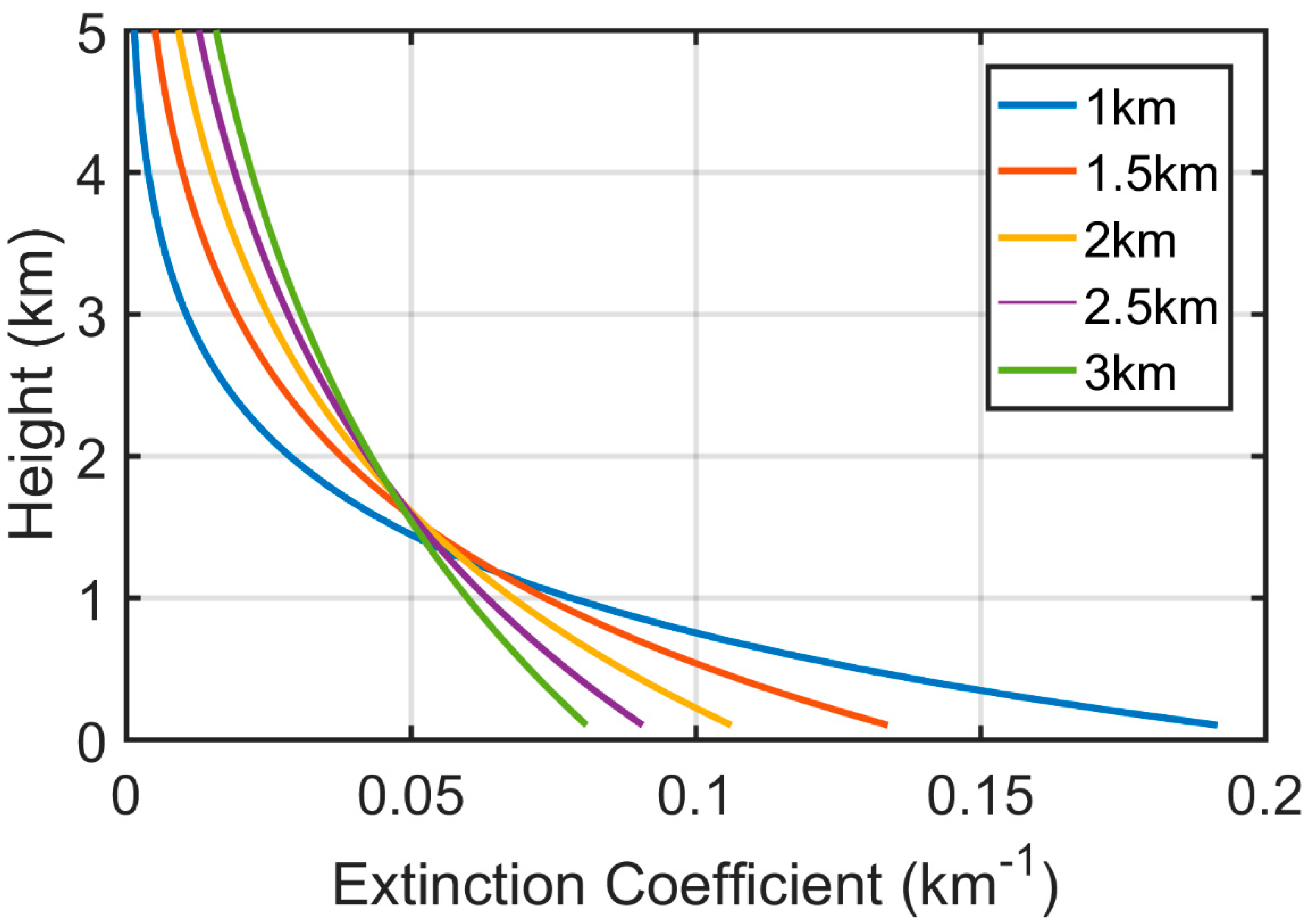

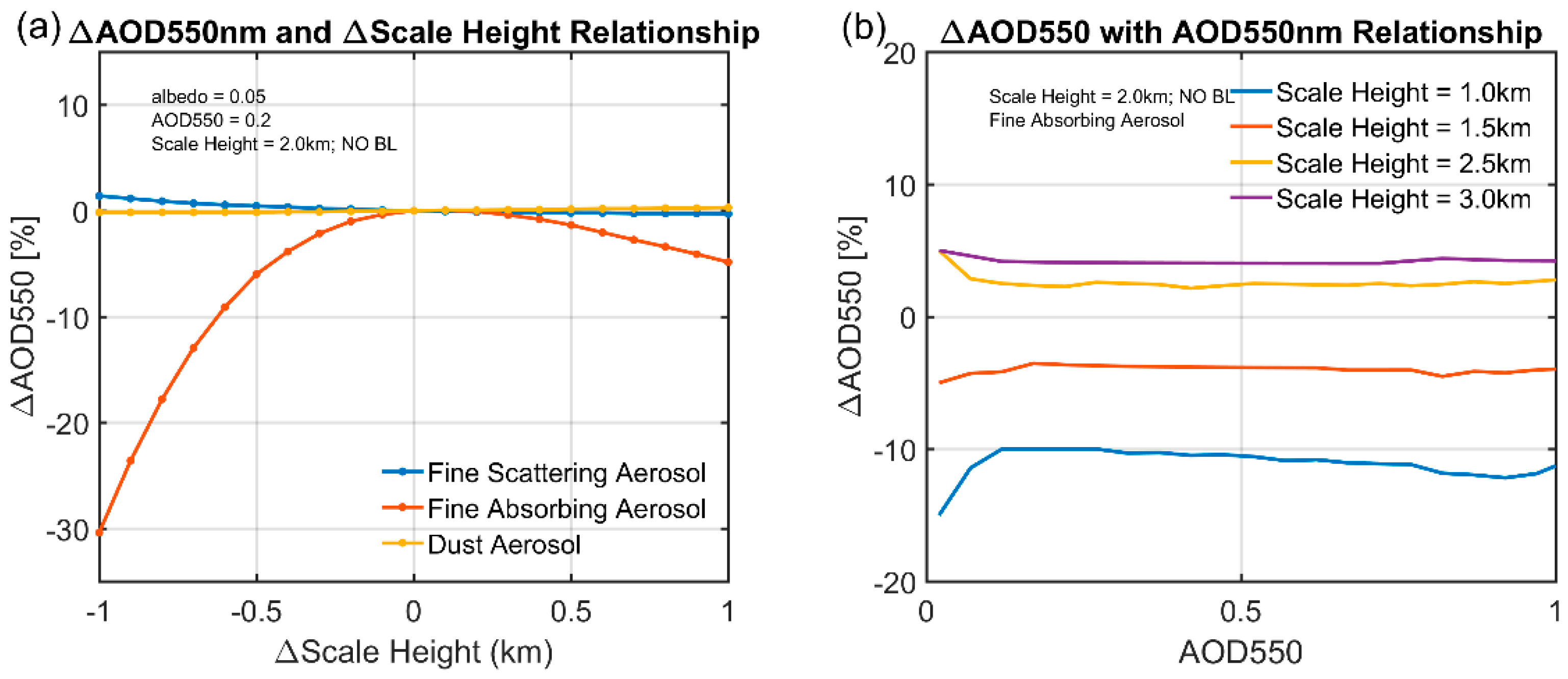

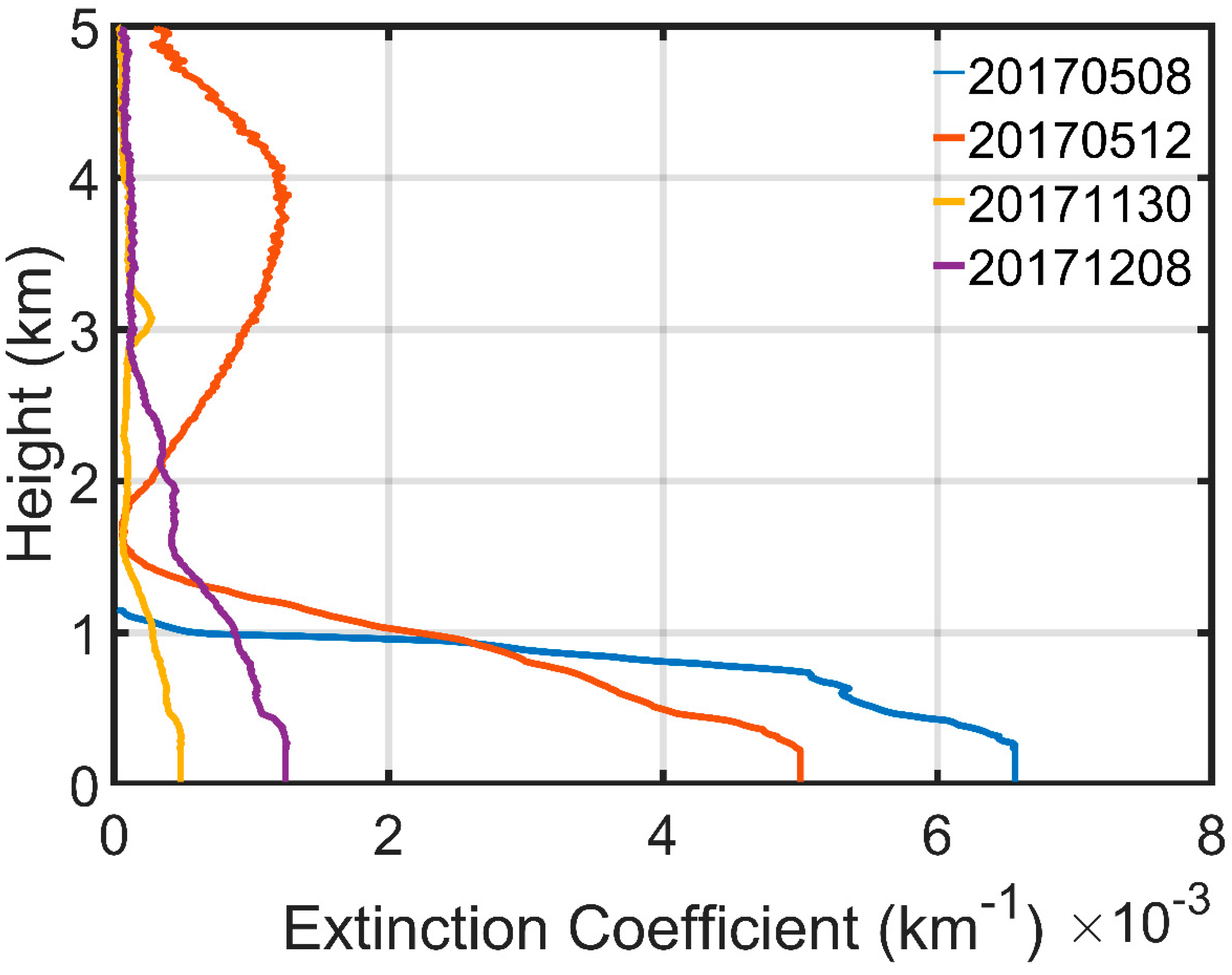
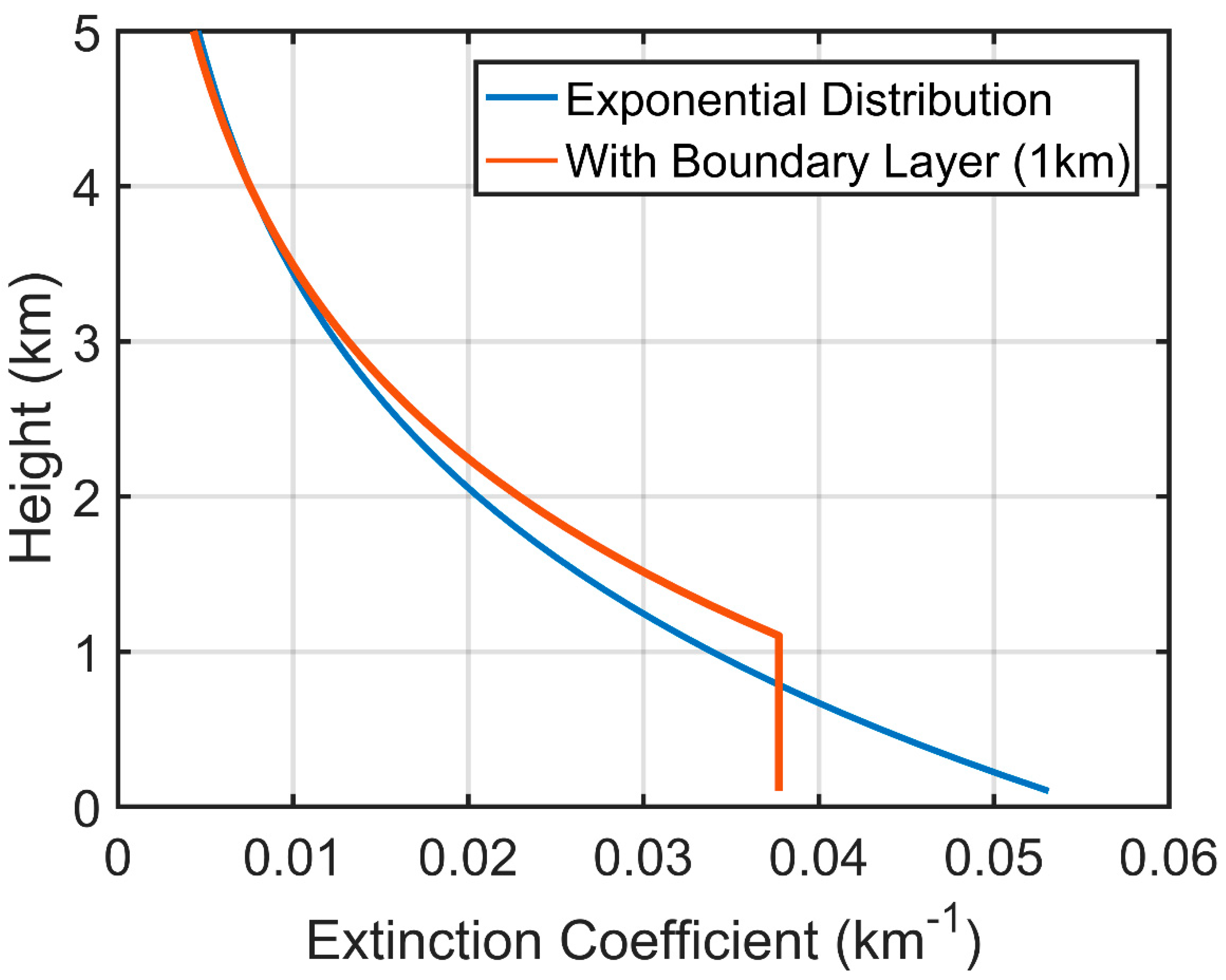
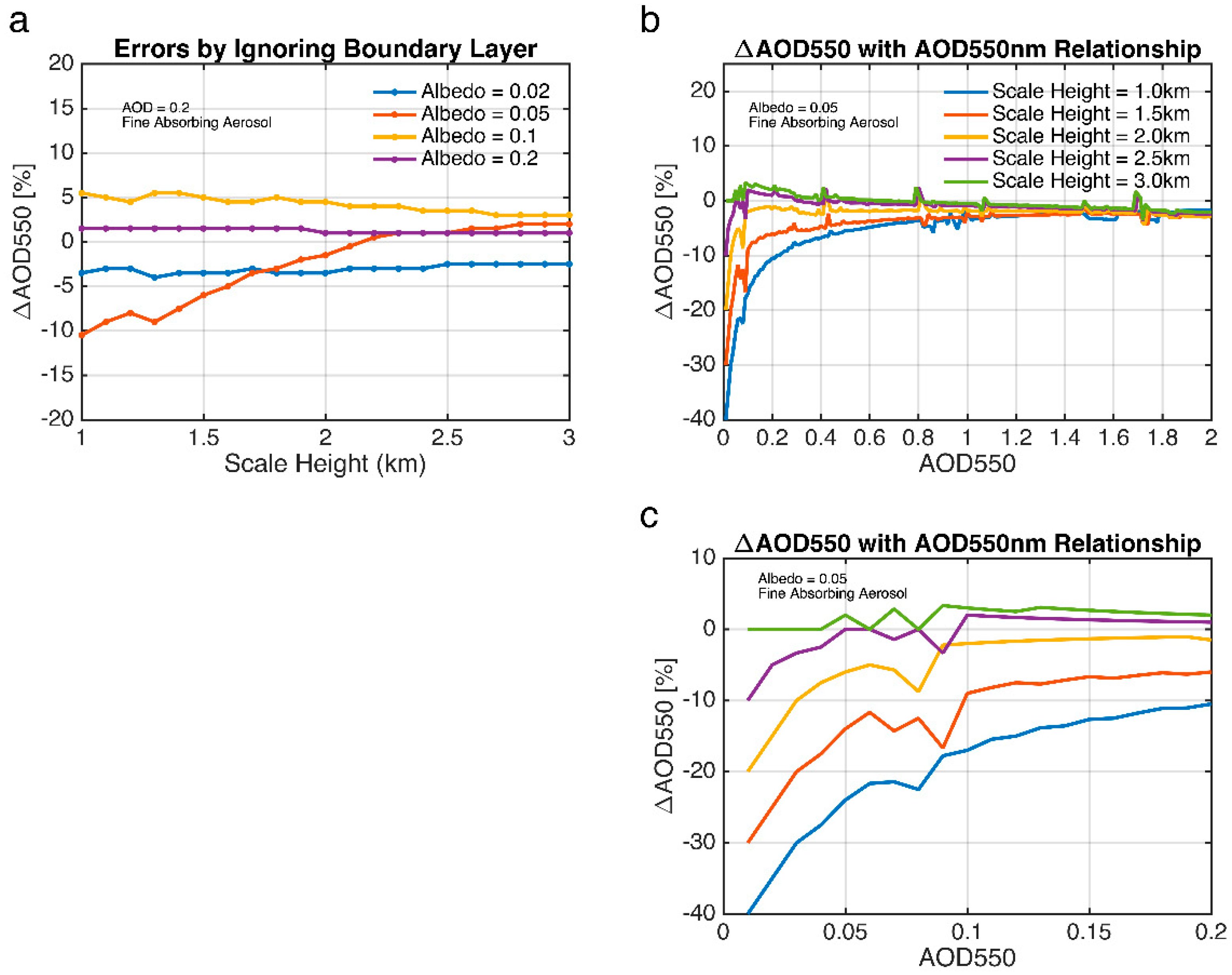
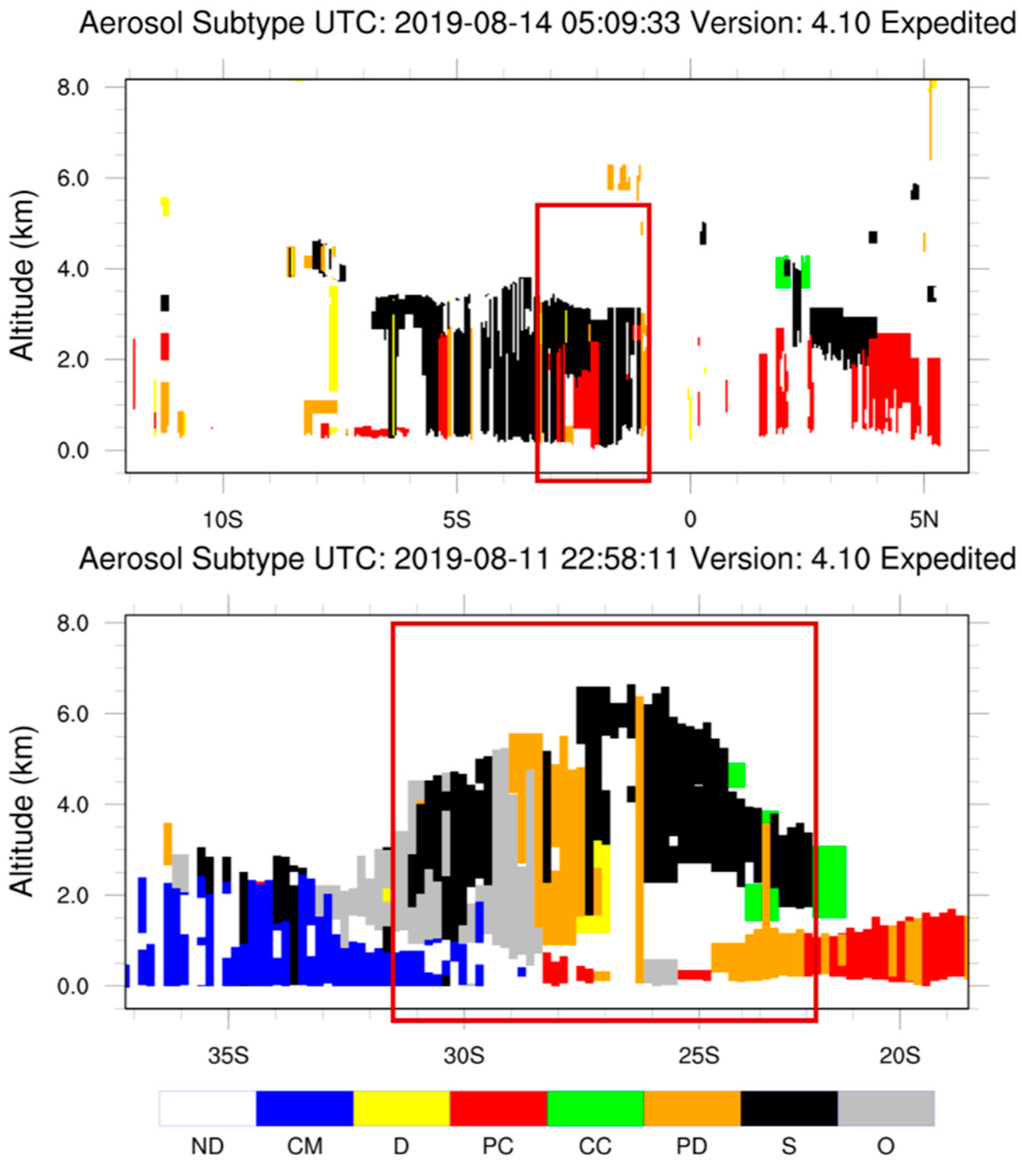
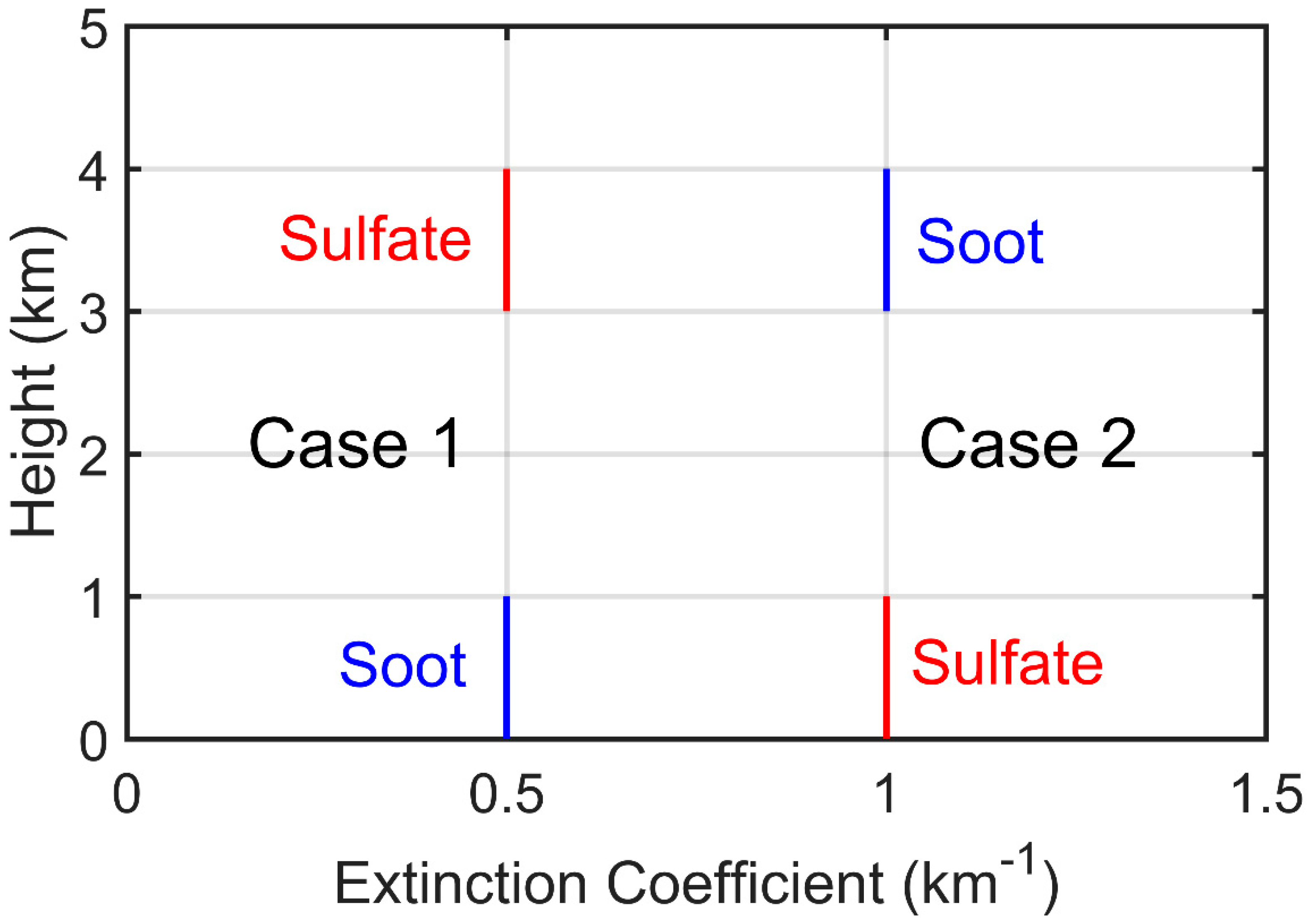

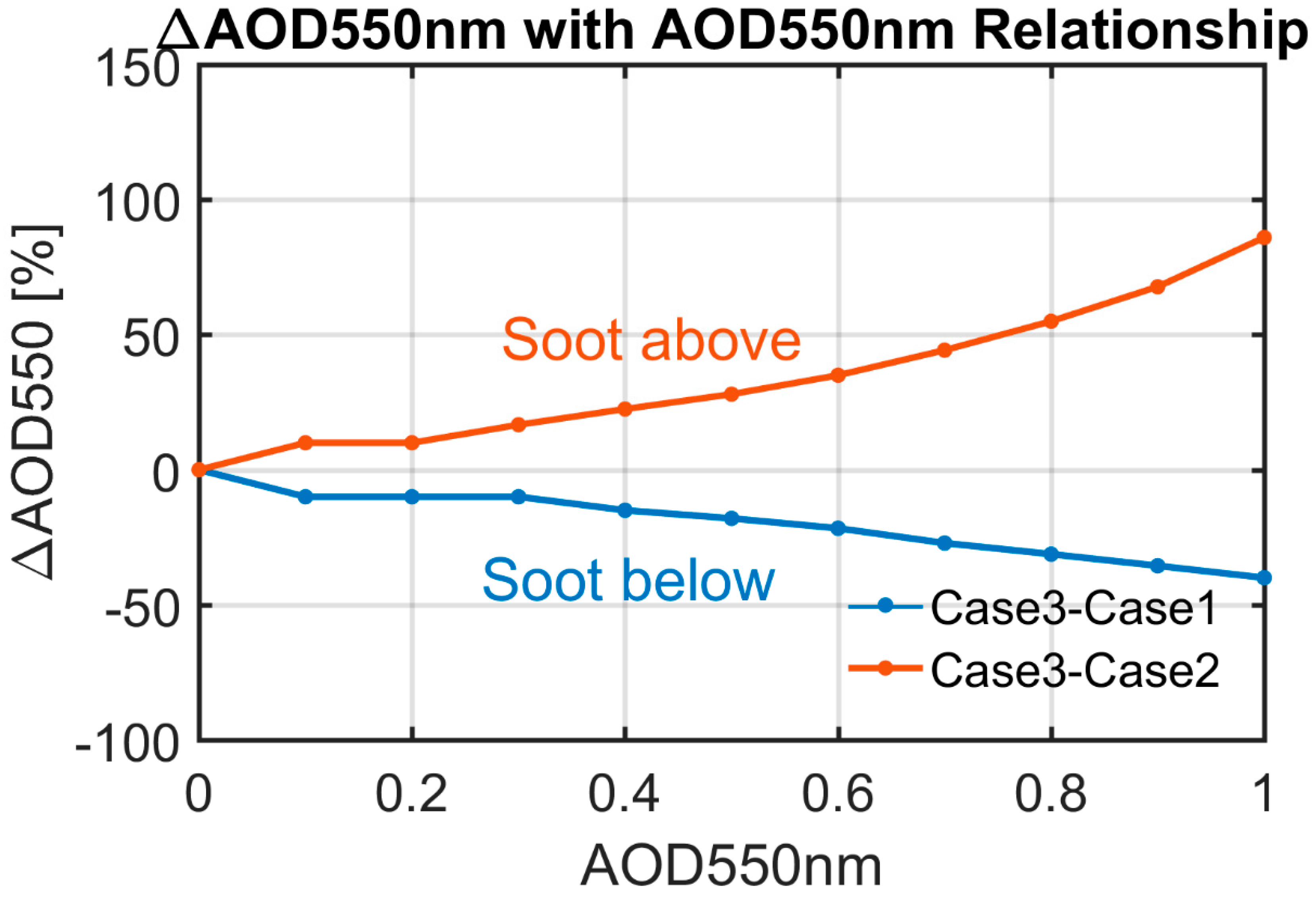
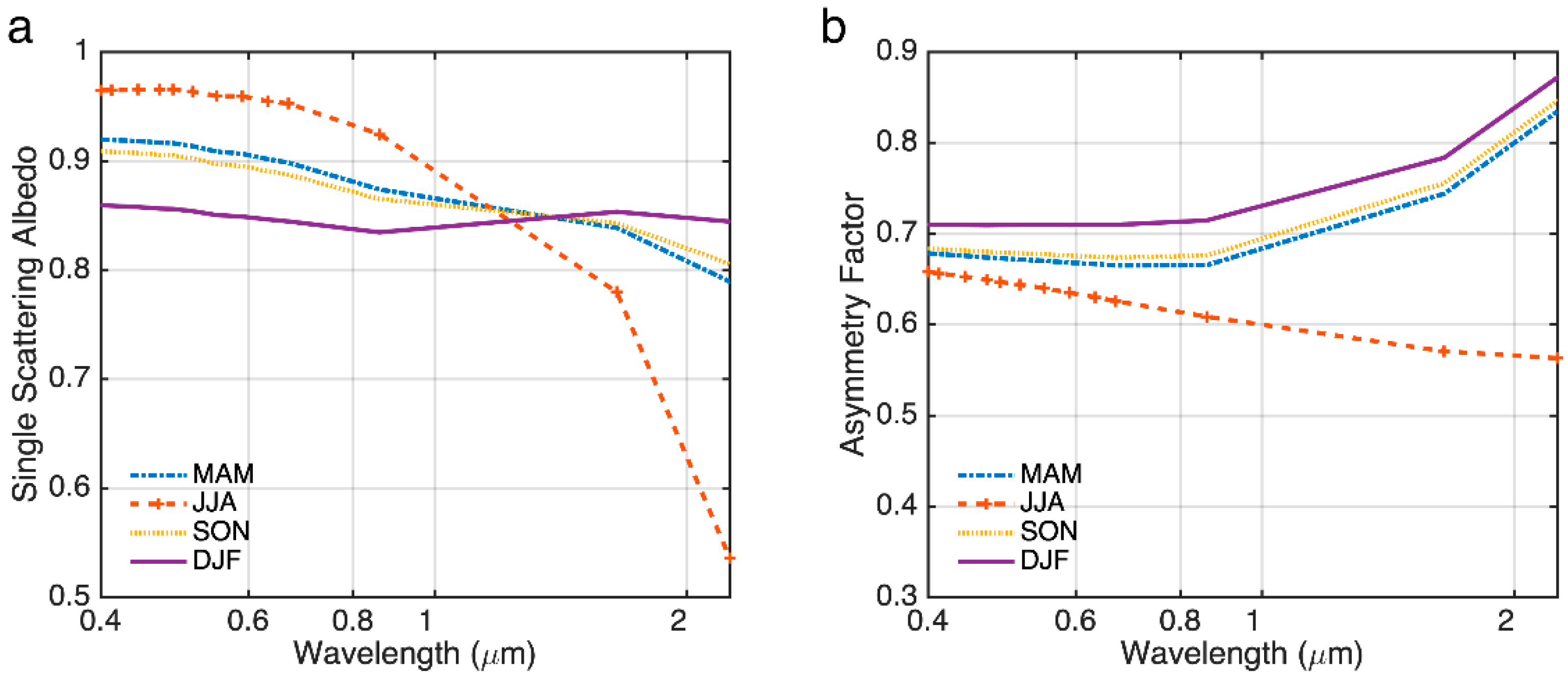
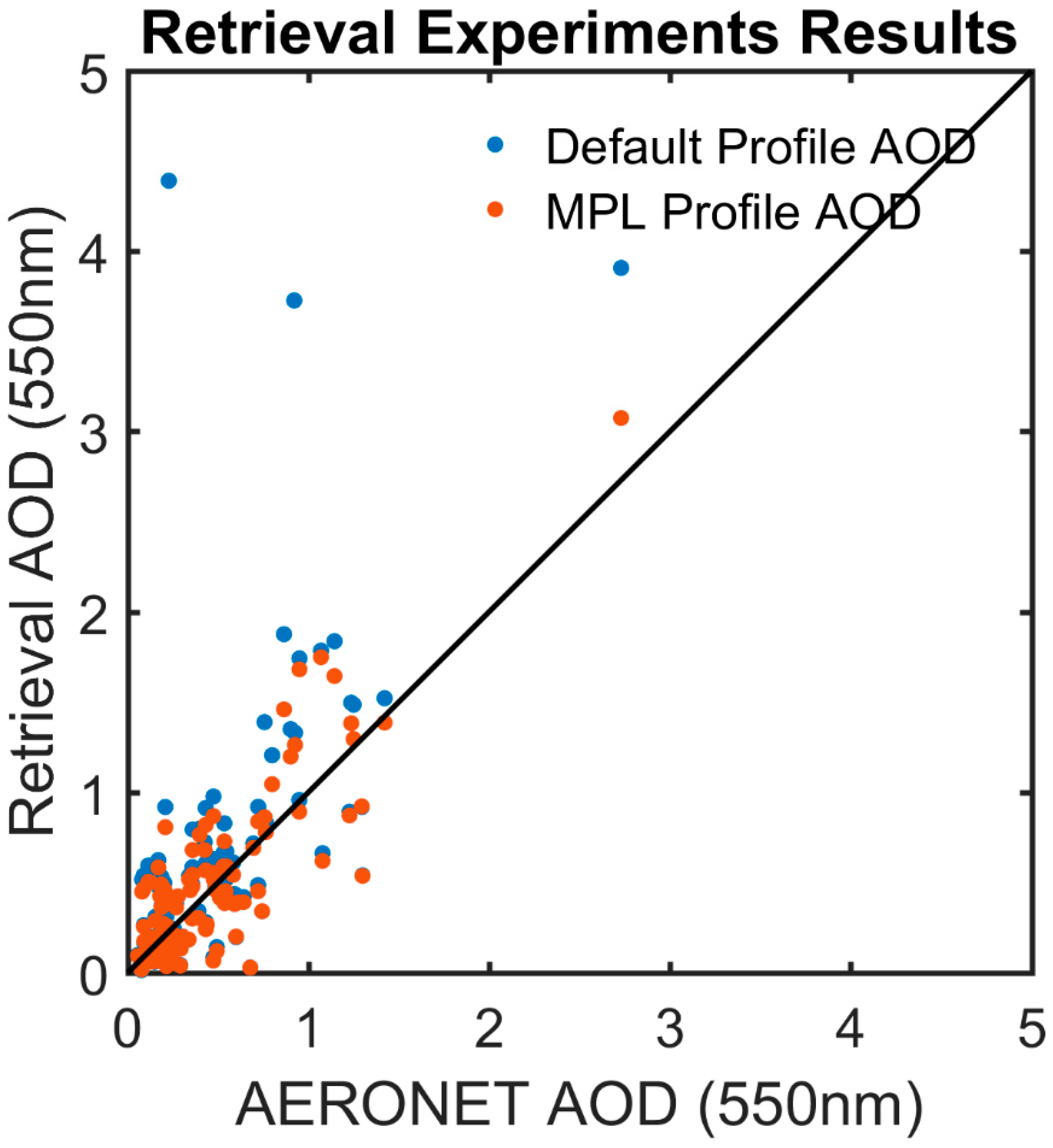

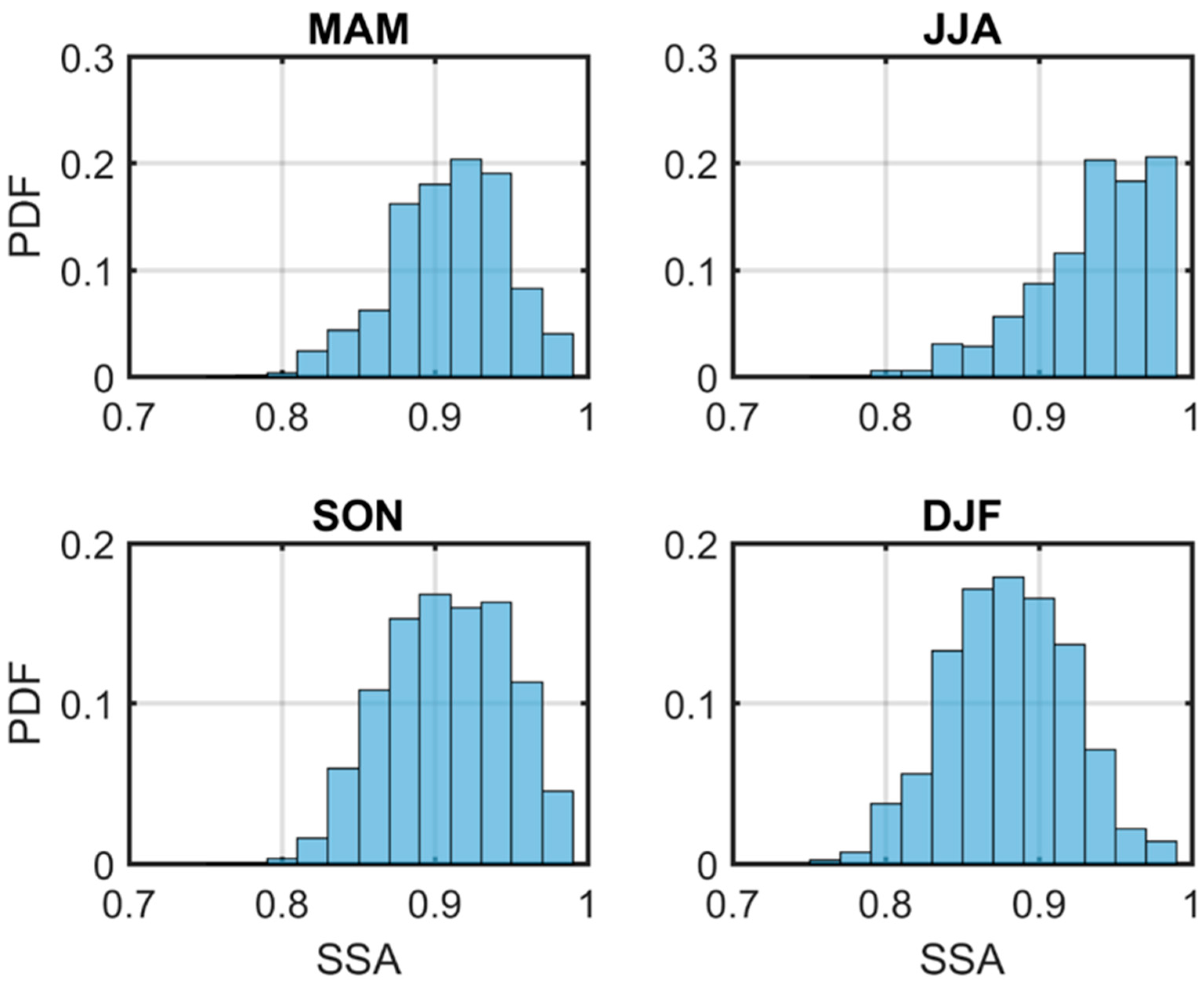

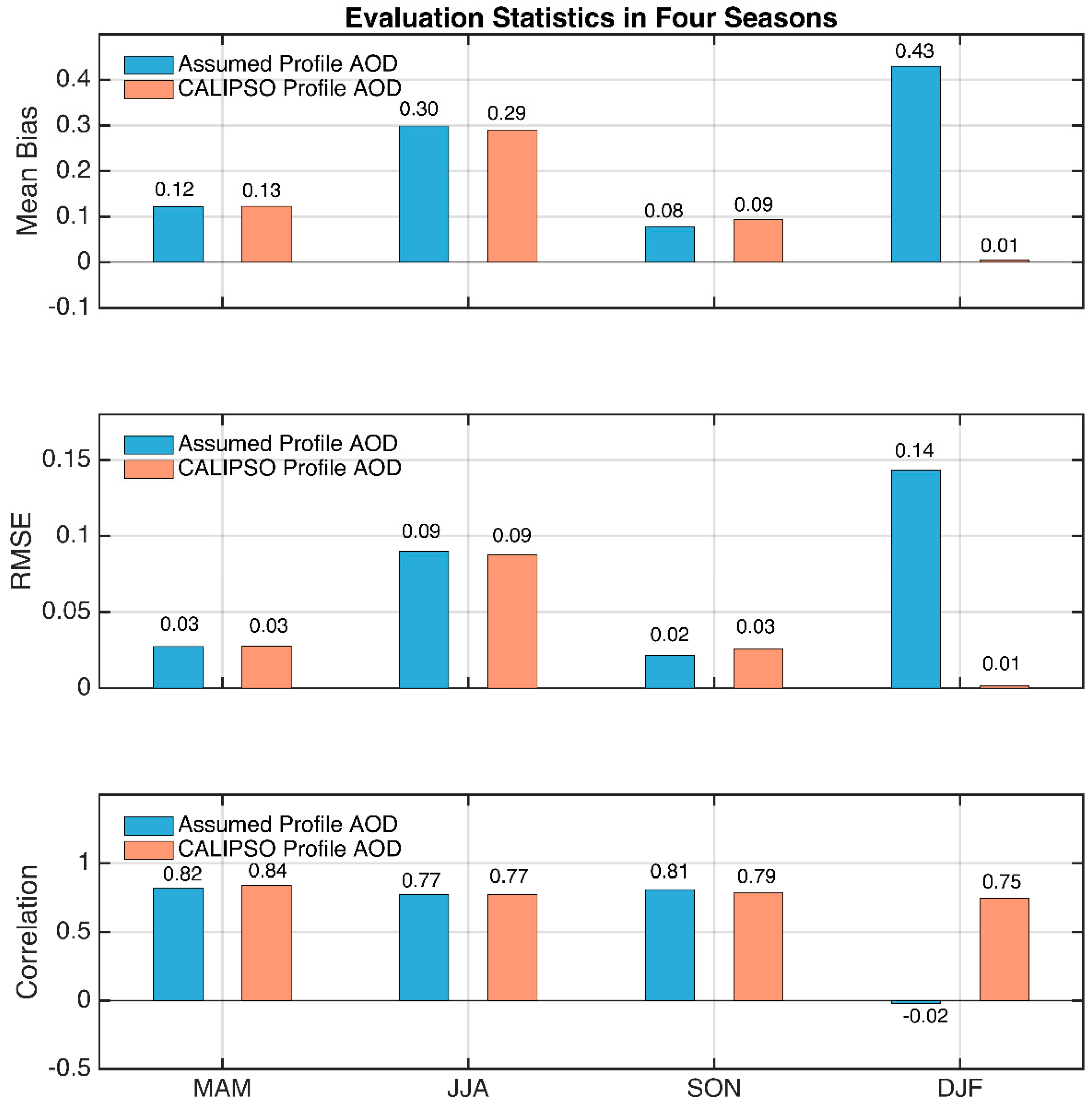
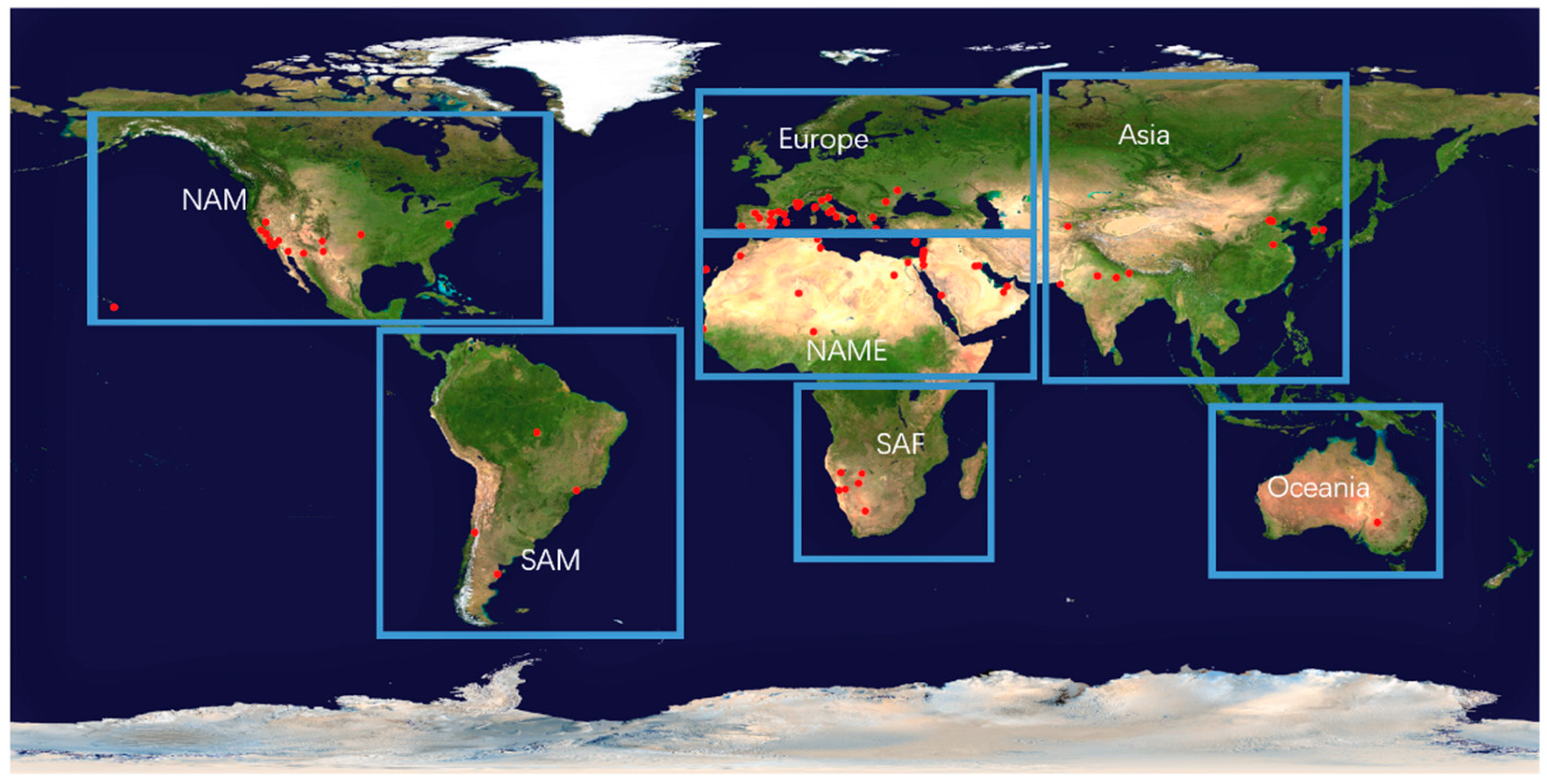


| Real Profiles | Assumed Profiles | |
|---|---|---|
| Mean Bias | 0.03 | 0.15 |
| RMSE | 0.002 | 0.015 |
| Correlation | 0.83 | 0.63 |
© 2020 by the authors. Licensee MDPI, Basel, Switzerland. This article is an open access article distributed under the terms and conditions of the Creative Commons Attribution (CC BY) license (http://creativecommons.org/licenses/by/4.0/).
Share and Cite
Li, C.; Li, J.; Dubovik, O.; Zeng, Z.-C.; Yung, Y.L. Impact of Aerosol Vertical Distribution on Aerosol Optical Depth Retrieval from Passive Satellite Sensors. Remote Sens. 2020, 12, 1524. https://doi.org/10.3390/rs12091524
Li C, Li J, Dubovik O, Zeng Z-C, Yung YL. Impact of Aerosol Vertical Distribution on Aerosol Optical Depth Retrieval from Passive Satellite Sensors. Remote Sensing. 2020; 12(9):1524. https://doi.org/10.3390/rs12091524
Chicago/Turabian StyleLi, Chong, Jing Li, Oleg Dubovik, Zhao-Cheng Zeng, and Yuk L. Yung. 2020. "Impact of Aerosol Vertical Distribution on Aerosol Optical Depth Retrieval from Passive Satellite Sensors" Remote Sensing 12, no. 9: 1524. https://doi.org/10.3390/rs12091524
APA StyleLi, C., Li, J., Dubovik, O., Zeng, Z.-C., & Yung, Y. L. (2020). Impact of Aerosol Vertical Distribution on Aerosol Optical Depth Retrieval from Passive Satellite Sensors. Remote Sensing, 12(9), 1524. https://doi.org/10.3390/rs12091524





